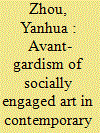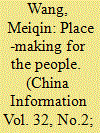| Srl | Item |
| 1 |
ID:
193189


|
|
|
|
|
| Summary/Abstract |
This article sheds light on the place of avant-gardism in socially engaged art and how it is reformulated in practice, through critically examining the art practices of the Yangdeng Art Cooperatives, a socially engaged art project in a rural area of Southwest China, where artists create various collaborative artworks and site-specific projects with the local people. I argue that the project contributes to an avant-garde mode of socially engaged art through aestheticizing the ordinariness of the everyday. I term this process ‘ordinary aesthetics’. This term demonstrates potential connections in our everyday lives and redefines the relationship between aesthetics and politics by regarding aesthetics as a perceivable sensate and a distribution of the sensible. In aiming to promote the ordinary, artists engage in local residents’ everyday lives by transforming their ordinary objects, spaces, and incidents into works of art. It is art that makes their ordinariness extraordinary. Technically, the artists blur the boundary between the real and the fictional to aestheticize the everyday lives of local residents. In their practices, ordinary aesthetics consequently becomes a means to rediscover the avant-gardism of socially engaged art.
|
|
|
|
|
|
|
|
|
|
|
|
|
|
|
|
| 2 |
ID:
160503


|
|
|
|
|
| Summary/Abstract |
In the past decade, socially engaged artistic practices have become a growing trend in China, embraced not only by contemporary art circles but also by broad intellectual communities. In this article, I explore this under-studied trend by looking at the practices of a number of art professionals who engage themselves with place-making in different rural villages against the backdrop of a rapidly declining countryside which has resulted from China’s top–down, GDP-driven urbanization and social development. Mainstream place-making, led by government in collaboration with private developers, has been primarily concerned with a good business environment in order to attract the highly mobile elite class or realize a quick return from speculative development. Place-making led by art professionals, on the contrary, aims to revitalize the deprived countryside through art and cultural activities, foster the growth of place-specific civic spaces, and accentuate the participation of local, grass-roots populations as well as the collaboration of urban intellectuals from various backgrounds. I argue that the efforts of these art professionals not only provide critical reflections and bottom–up alternatives to the dominant social developmental discourse, but also activate and expand the potential of art as an agent of social intervention, community building, and cultural change.
|
|
|
|
|
|
|
|
|
|
|
|
|
|
|
|